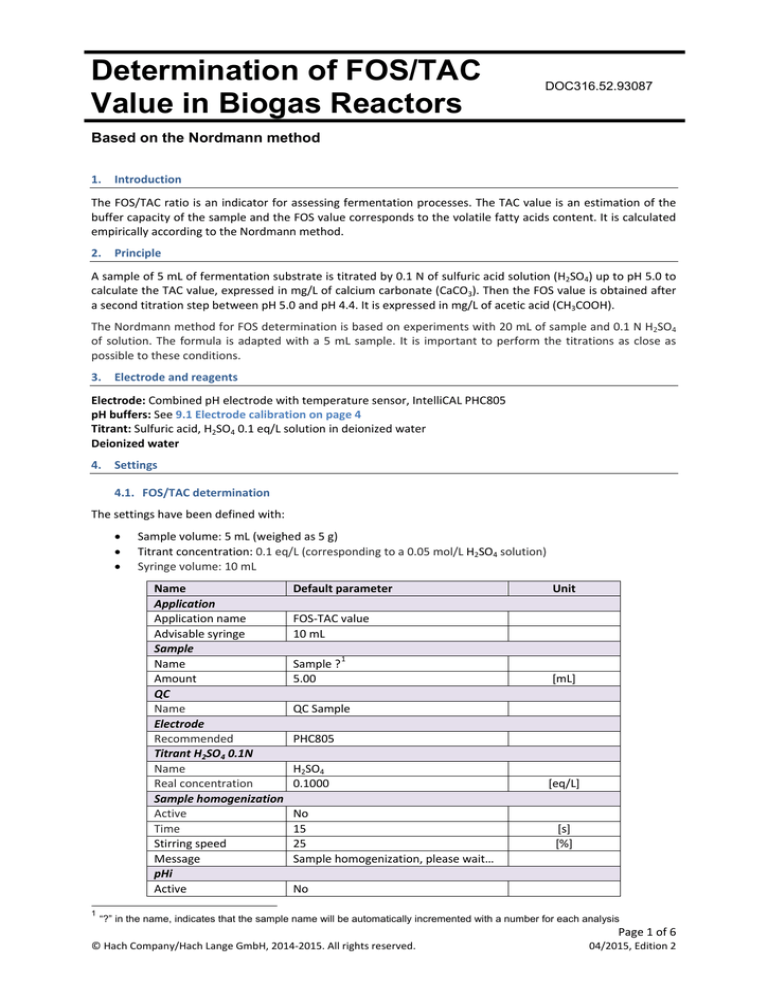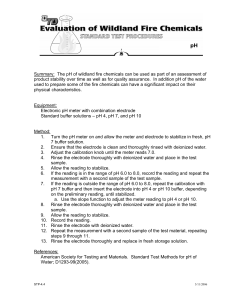
Determination of FOS/TAC
Value in Biogas Reactors
DOC316.52.93087
Based on the Nordmann method
1.
Introduction
The FOS/TAC ratio is an indicator for assessing fermentation processes. The TAC value is an estimation of the
buffer capacity of the sample and the FOS value corresponds to the volatile fatty acids content. It is calculated
empirically according to the Nordmann method.
2.
Principle
A sample of 5 mL of fermentation substrate is titrated by 0.1 N of sulfuric acid solution (H2SO4) up to pH 5.0 to
calculate the TAC value, expressed in mg/L of calcium carbonate (CaCO3). Then the FOS value is obtained after
a second titration step between pH 5.0 and pH 4.4. It is expressed in mg/L of acetic acid (CH3COOH).
The Nordmann method for FOS determination is based on experiments with 20 mL of sample and 0.1 N H2SO4
of solution. The formula is adapted with a 5 mL sample. It is important to perform the titrations as close as
possible to these conditions.
3.
Electrode and reagents
Electrode: Combined pH electrode with temperature sensor, IntelliCAL PHC805
pH buffers: See 9.1 Electrode calibration on page 4
Titrant: Sulfuric acid, H2SO4 0.1 eq/L solution in deionized water
Deionized water
4.
Settings
4.1. FOS/TAC determination
The settings have been defined with:
•
•
•
Sample volume: 5 mL (weighed as 5 g)
Titrant concentration: 0.1 eq/L (corresponding to a 0.05 mol/L H2SO4 solution)
Syringe volume: 10 mL
Name
Application
Application name
Advisable syringe
Sample
Name
Amount
QC
Name
Electrode
Recommended
Titrant H2SO4 0.1N
Name
Real concentration
Sample homogenization
Active
Time
Stirring speed
Message
pHi
Active
1
Default parameter
Unit
FOS-TAC value
10 mL
Sample ? 1
5.00
[mL]
QC Sample
PHC805
H2SO4
0.1000
No
15
25
Sample homogenization, please wait…
[eq/L]
[s]
[%]
No
“?” in the name, indicates that the sample name will be automatically incremented with a number for each analysis
© Hach Company/Hach Lange GmbH, 2014-2015. All rights reserved.
Page 1 of 6
04/2015, Edition 2
Name
Max. stability time
Stability criterion
Stirring speed
Result 1 (R1) name
R1 hide
R1 min.
R1 max.
R1 QC min.
R1 QC max.
FOS/TAC
Active
Stirring speed
Predose ordinate
Predose speed
Delay
Max. vol. stop point
Ordinate stop point
Stop on last EQP
EP1 ordinate
EP2 ordinate
Result 1 (R1) name
R1 hide
R1 min
R1 max
R1 QC min
R1 QC max
R1 EQP index
R1 molar weight
Result 2 (R2) name
R2 hide
R2 min
R2 max
R2 QC min
R2 QC max
R2 EQP index
Result 3 (R3) name
R3 hide
R3 min
R3 max
R3 QC min
R3 QC max
R3 EQP index
Result 4 (R4) name
R4 hide
R4 min
R4 max
R4 QC min
R4 QC max
R4 equation
Result 5 (R5) name
R5 hide
R5 min
R5 max
R5 QC min
R5 QC max
R5 equation
Default parameter
120
0.050
0
pHi
No
0
14
0
14
Yes
25
6
20
10
25
4.0
Yes
5.0
4.4
TAC
No
0
25000
0
25000
1
100.087
A
Yes
0
25
0
25
1
B
Yes
0
25
0
25
2
FOS
No
0
82000
0
82000
500*((R3*4*1.66)-0.15)
FOS/TAC
No
0
10
0
10
(500*((R3*4*1.66)-0.15))/R1
© Hach Company/Hach Lange GmbH, 2014-2015. All rights reserved.
Unit
[s]
[pH/min]
[%]
[pH]
[pH]
[pH]
[pH]
[%]
[pH]
[mL/min]
[s]
[mL]
[pH]
[pH]
[pH]
[mg/L]
[mg/L]
[mg/L]
[mg/L]
[g/mol]
[mL]
[mL]
[mL]
[mL]
[mL]
[mL]
[mL]
[mL]
[mg/L CH3COOH]
[mg/L CH3COOH]
[mg/L CH3COOH]
[mg/L CH3COOH]
Page 2 of 6
04/2015, Edition 2
4.2. Recommendation for modification of settings
Mainly for analysis time reduction, some parameters can be adjusted. It has to be noticed that the impact can
be a loss of precision on the results.
A pH measurement can be added before the titration.
In order to follow the ISO 10523:2008 standard set the Active fields of Sample homogenization and pHi
sections to Yes. Or, if your SOP requires stirring during pH measurement, activate only the pHi section and set a
stirring speed, for example 25%.
5.
Procedure
5.1. Electrode / Titrant calibration
If the electrode and/or titrant calibration is required, see section 9 Appendix: Electrode and titrant
calibrations.
5.2. Sample analysis
Put 5 mL (weighed as 5 g) of roughly filtered substrate into a 150 mL PP beaker, dilute with 50 mL of deionized
water and add a magnetic stir bar. Place the beaker onto the titrator and launch the FOS/TAC value application
on the main menu. If it is enabled, an initial pH measurement is performed and then the titration starts. At the
end of the analysis, rinse the probe and the addition tip.
6.
Results
6.1. Displayed Results
At the end of the titration the following results are available:
1.
2.
3.
4.
pHi: initial pH measured before titration if enabled
TAC in mg/L as CaCO3
FOS in mg/L as CH3COOH
FOS/TAC value without unit
6.2. Results calculation
A × Ctit × 50045
TAC calculation:
TAC =
FOS calculation:
FOS = ((B × 4 × 1.66) - 0.15) × 500
Vsmp
Where:
A = Volume of titrant at pH 5.0 (mL)
Ctit = Concentration of titrant (eq/L)
Vsmp = Volume of sample (5 mL fixed by the FOS formula, for the Nordmann method)
B = Volume of titrant by difference at pH 4.4 (mL) = volume of titrant at pH 5.0 – volume of titrant at pH 4.4
7.
Examples of FOS/TAC determination
The results described below are indicative and obtained for a given sample in optimized conditions respecting
good laboratory practices. These indicative values are sample-dependent, electrode-dependent and operating
cell-dependent.
7.1. FOS/TAC determination of water treatment plant sample
Results for 10 determinations of a water treatment plant sample with default settings.
Sample: 5 mL of substrate + deionized water
Temperature of analysis: Room temperature
Mean value of FOS/TAC: 0.320
Standard deviation: 0.008
Relative standard deviation: 2.65%
Curve pH versus volume of titrant:
© Hach Company/Hach Lange GmbH, 2014-2015. All rights reserved.
Page 3 of 6
04/2015, Edition 2
8.
Bibliography
9.
McGhee T. J., 1968, A Method For Approximation of the Volatile Acid Concentrations in Anaerobic
Digesters, Water and Sewage Works, April 1968, Vol. 115, pp. 162-166.
Voß E., Weichgrebe D., Rosenwinkel, K. H., 2009, FOS/TAC-Deduction, Methods, Application and
Significance, Internationale Wissenschaftskonferenz „Biogas Science 2009 – science meets practice“,
LfL-Bayern, 2-4. 12.09, Erding.
Appendix: Electrode and titrant calibrations
To increase accuracy of the FOS/TAC determination, it is recommended to perform an electrode calibration
every week. For the titrant, it is recommended to calibrate it after a bottle change or after a long storage time.
9.1. Electrode calibration
9.1.1.
Electrode and buffers
Electrode: Combined pH electrode with temperature sensor, IntelliCAL PHC805.
pH standards: Color-coded pH 4.01, pH 7.00 and pH 10.01 are set by default. It is possible to change them
according to your SOP (refer to the full user manual for more details).
9.1.2.
Electrode calibration settings
By default the electrode calibration is done with the parameters described below:
Name
Application
Application name
Electrode
Recommended
Calibration frequency
Stability criterion
Max. stability time
Stirring speed
Stirring duration
Calibration mode
Buffer set
Default parameter
Unit
FOS-TAC value
PHC805
7
0.050
300
25
15
Auto
Color-coded 4.01, 7.00 and 10.01
[Day]
[pH/min]
[s]
[%]
[s]
Note: The parameters are defined to calibrate the electrode following the ISO 10523:2008 standard which
recommends stirring the buffer before the measurement, and to stop stirring during measurement. If your SOP
requires stirring during the measurement, set the Stirring duration to 0 s.
The calibration mode is set as Auto by default, but two other options are also available: Fixed and Manual.
Refer to the full user manual for more details.
9.1.3.
Electrode calibration procedure
It is recommended to calibrate the electrode at a temperature close to the sample temperature.
Pour a sufficient amount of buffer into a beaker so that the electrode dips into the solution. Add a magnetic bar
and launch the calibration sequence. Rinse the electrode between each buffer. The electrode can be calibrated
with up to five different buffers.
9.1.4.
Calibration results
At the end of the series of buffers, the following results are displayed:
•
•
•
Slope in mV/pH
Slope in % compared with theoretical slope (-59.16 mV/pH)
Offset in mV
The acceptance limits for the slope are 97-102% and between - 30 and + 30 mV for the offset.
© Hach Company/Hach Lange GmbH, 2014-2015. All rights reserved.
Page 4 of 6
04/2015, Edition 2
9.2. Titrant calibration
9.2.1.
Principle
The strong acid used as titrant has to be calibrated with Borax which reacts with H+ ions according to:
B4O72- + 2H+ + H2O 4HBO2
9.2.2. Electrode and reagents
Electrode:
Combined pH electrode with temperature sensor, IntelliCAL PHC805
Titrant:
Sulfuric acid, H2SO4 0.1 eq/L solution in deionized water
Standard:
Borax powder (M = 381.37 g/mol)
Deionized water
9.2.3.
Settings
The following parameters have been set to use about 5 mL of titrant for the calibration.
Name
Default parameter
Application
Application name
FOS-TAC value
Advisable syringe
10 mL
Electrode
Recommended
PHC805
H2SO4 0.1 N method: Calibration
Active
Yes
Calibration frequency
0
Stirring speed
25
Predose volume
2
Delay
5
Max. vol. stop point
8
Ordinate stop point
2.0
Stop on last EQP
Yes
IP1 min. ordinate
4.5
IP1 max. ordinate
6.5
Min. titrant conc.
0.9000
Max. titrant conc.
0.1100
Standard name
Borax
Standard amount
95
Min. amount
75
Max. amount
115
Concentration
99.5
Molar weight
381.372
9.2.4.
Unit
[Day]
[%]
[mL]
[s]
[mL]
[pH]
[pH]
[pH]
[eq/L]
[eq/L]
[mg]
[mg]
[mg]
[%]
[g/mol]
Procedure
Accurately weigh approximately 95 mg of Borax in a beaker and add a sufficient amount of deionized water to
cover the electrode and the delivery tip with solution. Put in a magnetic stir bar, place the beaker on the
titrator and dip the electrode and delivery tip into the solution. Launch the titrant calibration sequence.
© Hach Company/Hach Lange GmbH, 2014-2015. All rights reserved.
Page 5 of 6
04/2015, Edition 2
9.2.5.
Result
The result is expressed as eq/L concentration of the titrant and based on the following formula:
Where:
CH2SO4 =
mborax × Cborax
Mborax ×VH2SO4 ×50
CH2SO4 : Titrant concentration in eq/L
mborax : Mass of Borax in mg
Cborax : Concentration of Borax in % (purity of borax powder)
Mborax : Molar weight of Borax = 381.37 g/mol
VH2SO4 : Volume of H2SO4 at the equivalence point in mL
The calibration result can be accepted if five determinations give a result with a relative standard deviation of
less than 0.5%.
9.2.6.
Example of titrant calibration
Results for 10 titrant calibrations using the default parameters:
The results described below are indicative and obtained for a given titrant in optimized conditions respecting
good laboratory practices. These indicative values are sample-dependent, electrode-dependent and operating
cell-dependent.
Standard: 95 mg of 99.5% Borax powder dissolved in
100 mL of deionized water
Temperature of analysis: Room temperature
Concentration of titrant: 0.0997 eq/L
SD: 0.0001 eq/L
RSD: 0.09 %
Titration curve:
© Hach Company/Hach Lange GmbH, 2014-2015. All rights reserved.
Page 6 of 6
04/2015, Edition 2





